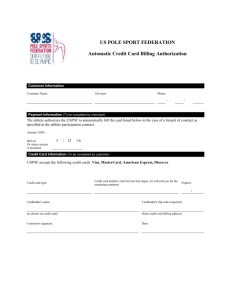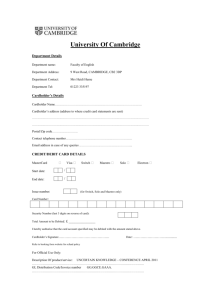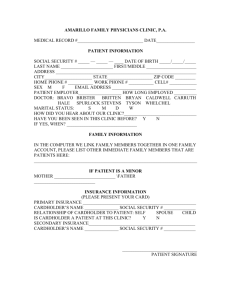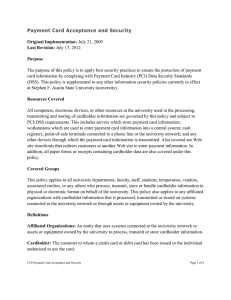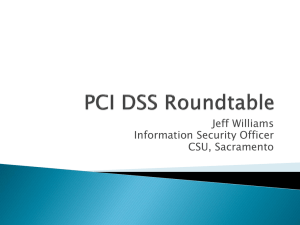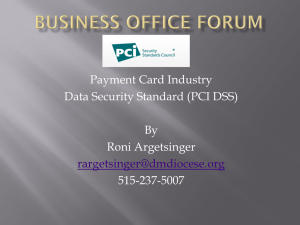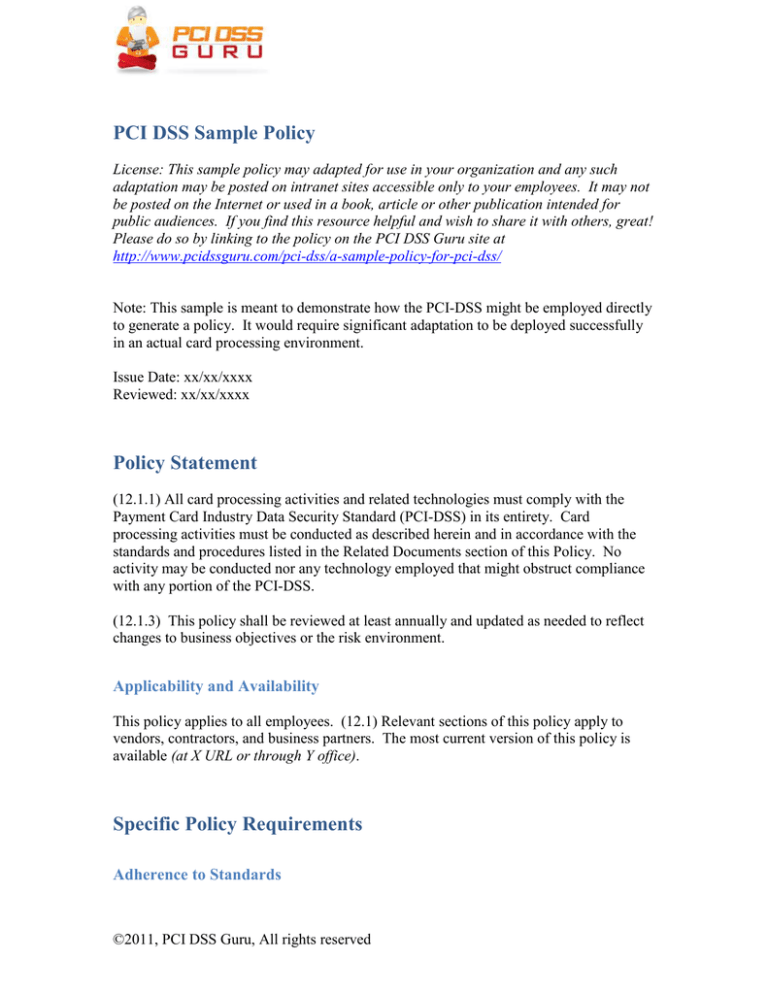
PCI DSS Sample Policy
License: This sample policy may adapted for use in your organization and any such
adaptation may be posted on intranet sites accessible only to your employees. It may not
be posted on the Internet or used in a book, article or other publication intended for
public audiences. If you find this resource helpful and wish to share it with others, great!
Please do so by linking to the policy on the PCI DSS Guru site at
http://www.pcidssguru.com/pci-dss/a-sample-policy-for-pci-dss/
Note: This sample is meant to demonstrate how the PCI-DSS might be employed directly
to generate a policy. It would require significant adaptation to be deployed successfully
in an actual card processing environment.
Issue Date: xx/xx/xxxx
Reviewed: xx/xx/xxxx
Policy Statement
(12.1.1) All card processing activities and related technologies must comply with the
Payment Card Industry Data Security Standard (PCI-DSS) in its entirety. Card
processing activities must be conducted as described herein and in accordance with the
standards and procedures listed in the Related Documents section of this Policy. No
activity may be conducted nor any technology employed that might obstruct compliance
with any portion of the PCI-DSS.
(12.1.3) This policy shall be reviewed at least annually and updated as needed to reflect
changes to business objectives or the risk environment.
Applicability and Availability
This policy applies to all employees. (12.1) Relevant sections of this policy apply to
vendors, contractors, and business partners. The most current version of this policy is
available (at X URL or through Y office).
Specific Policy Requirements
Adherence to Standards
©2011, PCI DSS Guru, All rights reserved
(2.2.a) Configuration standards must be maintained for applications, network components,
critical servers, and wireless access points. These standards must be consistent with
industry-accepted hardening standards as defined, for example, by SysAdmin Assessment
Network Security Network (SANS), National Institute of Standards Technology (NIST),
and Center for Internet Security (CIS). [2.2.b should be captured in your system
configuration standard; 2.2.c and 2.2.3.b should be covered in your procedure for new
server set-up]
Configuration standards must include:
•
(5.2) updating of anti-virus software and definitions
•
(6.1.b) provision for installation of all relevant new security
patches within 30 days
•
(8.5.8.b) prohibition of group and shared passwords
Handling of Cardholder Data
(9.7) Distribution, maintenance, and storage of media containing cardholder data, must be
controlled, including that distributed to individuals. (9.9) Procedures must include
periodic media inventories in order to validate the effectiveness of these controls.
(3.1) Procedures for data retention and disposal must be maintained by each department
and must include the following:
•
legal, regulatory, and business requirements for data retention,
including specific requirements for retention of cardholder data
•
provisions for disposal of data when no longer needed for legal,
regulatory, or business reasons, including disposal of cardholder data
•
coverage for all storage of cardholder data, including database
servers, mainframes, transfer directories, and bulk data copy directories used to
transfer data between servers, and directories used to
•
a programmatic (automatic) process to remove, at least on a
quarterly basis, stored cardholder data that exceeds business retention
requirements, or, alternatively, an audit process, conducted at least on a quarterly
basis, to verify that stored cardholder data does not exceed business retention
requirements
•
(9.10) destruction of media when it is no longer needed for
business or legal reasons as follows:
◦
cross-cut shred, incinerate, or pulp hardcopy materials
◦
purge, degauss, shred, or otherwise destroy electronic
media such that data cannot be reconstructed
[If records management is a centralized function, you may choose to offload the above
section to a data retention standard and/or procedure, and then reference that procedure
in the policy.]
©2011, PCI DSS Guru, All rights reserved
(3.3) Credit card numbers must be masked when displaying cardholder data. Those with
a need to see full credit card numbers must request an exception to this policy using the
exception process.
(4.2.b) Unencrypted Primary Account Numbers may not be sent via email
Access to Cardholder Data
(7.1) Procedures for data control must be maintained by each department and must
incorporate the following:
•
Access rights to privileged User IDs are restricted to least
privileges necessary to perform job responsibilities
•
Assignment of privileges is based on individual personnel's job
classification and function
•
Requirement for an authorization form signed by management that
specifies required privileges
•
Implementation of an automated access control system
Critical Employee-facing Technologies
(12.3) For critical employee-facing technologies, departmental procedures shall require:
•
(12.3.1) explicit management approval to use the devices
•
(12.3.2) that all device use is authenticated with username and
password or other authentication item (for example, token)
•
(12.3.3) a list of all devices and personnel authorized to use the
devices
•
(12.3.4) labeling of devices with owner, contact information, and
purpose
•
(12.3.8) automatic disconnect of modem sessions after a specific
period of inactivity
•
(12.3.9) activation of modems used by vendors only when needed
by vendors, with immediate deactivation after use
•
Departmental usage standards shall include:
•
(12.3.5) acceptable uses for the technology
•
(12.3.6) acceptable network locations for the technology
•
(12.3.7) a list of company-approved products
•
(12.3.10) prohibition of the storage of cardholder data onto local
hard drives, floppy disks, or other external media when accessing such data
remotely via modem
•
(12.3.10) prohibition of use of cut-and-paste and print functions
during remote access
(12.4) Responsibilities
©2011, PCI DSS Guru, All rights reserved
Responsibilities
12.2.a Will maintain daily operational security procedures consistent with this the PCIDSS, including administrative and technical procedures for each of the requirements
(12.5) Chief Security Officer (or equivalent) is responsible for overseeing all aspects of
information security, including but not limited to:
•
(12.5.1) creating and distributing security policies and procedures
•
(12.5.2) monitoring and analyzing security alerts and distributing
information to appropriate information security and business unit management
personnel
•
(12.5.3) (12.9) creating and distributing security incident response
and escalation procedures that include:
◦
(12.9.1) roles, responsibilities, and communication
◦
(12.9.1) coverage and responses for all critical system
components
◦
(12.9.1) notification, at a minimum, of credit card
associations and acquirers
◦
(12.9.1) strategy for business continuity post compromise
◦
(12.9.1) reference or inclusion of incident response
procedures from card associations
◦
(12.9.1) analysis of legal requirements for reporting
compromises (for example, per California bill 1386)
◦
(12.9.2) annual testing
◦
(12.9.3, 12.9.5) designation of personnel to monitor for
intrusion detection, intrusion prevention, and file integrity monitoring
alerts on a 24/7 basis
◦
(12.9.4) plans for periodic training
◦
(12.9.6) a process for evolving the incident response plan
according to lessons learned and in response to industry developments
•
(12.6; 12.6.1.a) maintaining a formal security awareness program
for all employees that providesmultiple methods of communicating awareness and
educating employees (for example, posters, letters, meetings)
•
(10.6.a) review security logs at least daily and follow-up on
exceptions
(12.2.a) The Information Technology Office (or equivalent) shall maintain daily
administrative and technical operational security procedures that are consistent with the
PCI-DSS (for example, user account maintenance procedures, and log review procedures).
System and Application Administrators shall
•
Monitor and analyze security alerts and information and distribute
to appropriate personnel
•
(12.5.4) administer user accounts and manage authentication
•
(12.5.5) monitor and control all access to data
•
(12.10.1) maintain a list of connected entities
©2011, PCI DSS Guru, All rights reserved
•
(12.10.2) perform due diligence prior to connecting an entity, with
supporting documentation
•
(12.10.3, 12.4) verify that the entity is PCI-DSS compliant, with
supporting documentation
•
(12.10.4) establish a documented procedure for connecting and
disconnecting entities
•
(10.7.a ) retain audit logs for at least one year
The Human Resources Office (or equivalent) is responsible for tracking employee
participation in the security awareness program, including:
•
(12.6.1.b) facilitating participation upon hire and at least annually
•
(12.6.2) ensuring that employees acknowledge in writing that they
have read and understand the company's information security policy
•
(12.7) screen potential employees to minimize the risk of attacks
from internal sources
Internal Audit (or equivalent) is responsible for executing a (12.1.2) risk assessment
process that identifies threats, vulnerabilities, and results in a formal risk assessment.
General Counsel (or equivalent) will ensure that for service providers with whom
cardholder information is shared:
•
(12.8.1, 12.4) contracts require adherence to PCI-DSS by the
service provider
•
(12.8.2, 12.4) contracts include acknowledgement or responsibility
for the security of cardholder data by the service provider
Related Documents
List standards here.
Some procedures may be listed here, but generally, standards should refer to specific
procedures.
©2011, PCI DSS Guru, All rights reserved

